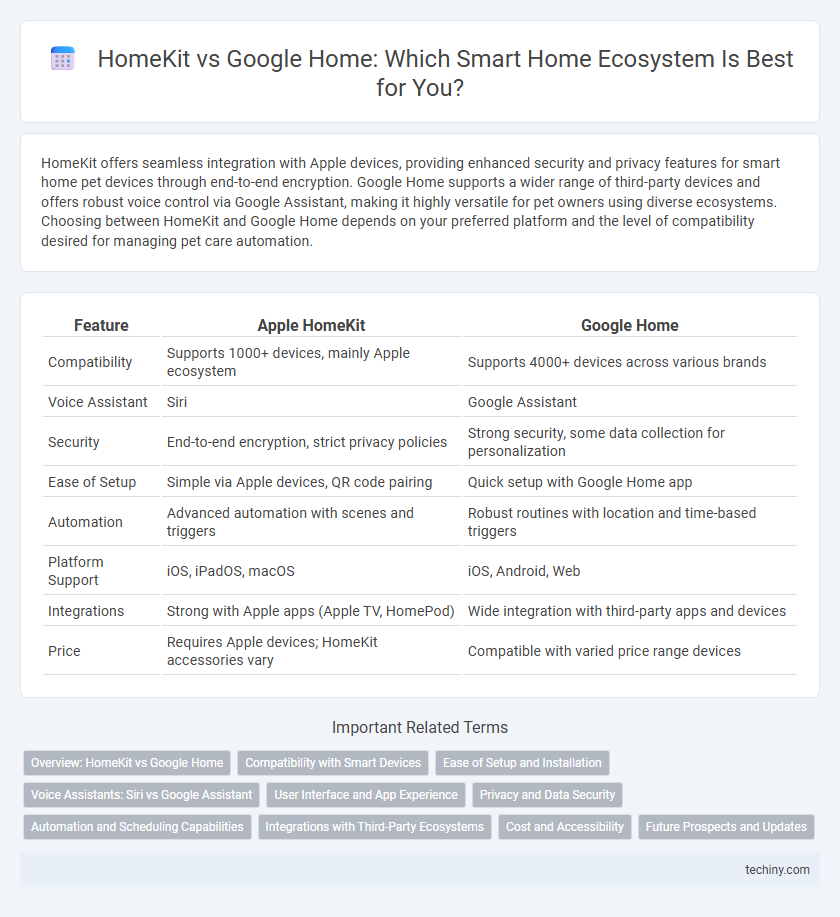HomeKit offers seamless integration with Apple devices, providing enhanced security and privacy features for smart home pet devices through end-to-end encryption. Google Home supports a wider range of third-party devices and offers robust voice control via Google Assistant, making it highly versatile for pet owners using diverse ecosystems. Choosing between HomeKit and Google Home depends on your preferred platform and the level of compatibility desired for managing pet care automation.
Table of Comparison
| Feature | Apple HomeKit | Google Home |
|---|---|---|
| Compatibility | Supports 1000+ devices, mainly Apple ecosystem | Supports 4000+ devices across various brands |
| Voice Assistant | Siri | Google Assistant |
| Security | End-to-end encryption, strict privacy policies | Strong security, some data collection for personalization |
| Ease of Setup | Simple via Apple devices, QR code pairing | Quick setup with Google Home app |
| Automation | Advanced automation with scenes and triggers | Robust routines with location and time-based triggers |
| Platform Support | iOS, iPadOS, macOS | iOS, Android, Web |
| Integrations | Strong with Apple apps (Apple TV, HomePod) | Wide integration with third-party apps and devices |
| Price | Requires Apple devices; HomeKit accessories vary | Compatible with varied price range devices |
Overview: HomeKit vs Google Home
Apple HomeKit offers a seamless smart home experience through tight integration with iOS devices, emphasizing privacy and secure connections via end-to-end encryption. Google Home provides broad compatibility across various smart devices and supports voice control through Google Assistant, prioritizing flexibility and expansive device ecosystem. Both platforms enable intelligent automation and device management but differ in system openness and user privacy approaches.
Compatibility with Smart Devices
HomeKit supports seamless integration with Apple-certified smart devices, ensuring reliable performance and enhanced security through strict device compatibility standards. Google Home offers broader compatibility with a wide range of third-party smart devices across multiple brands, providing greater flexibility for diverse smart home ecosystems. Choosing between the two depends on whether you prioritize Apple's controlled environment or Google's extensive device support.
Ease of Setup and Installation
HomeKit offers seamless setup through the Apple Home app, automatically recognizing compatible devices with minimal manual input, making it ideal for users entrenched in the Apple ecosystem. Google Home provides a straightforward installation via the Google Home app, leveraging voice prompts and intuitive device pairing, catering to a broader range of smart devices and platforms. Both platforms prioritize user-friendly installation, but HomeKit emphasizes secure, zero-configuration integration, while Google Home excels in flexibility and device compatibility.
Voice Assistants: Siri vs Google Assistant
Siri, integrated with Apple HomeKit, offers seamless voice control for smart home devices within the Apple ecosystem, emphasizing privacy and secure encrypted communication. Google Assistant, powering Google Home, provides broader device compatibility and more natural language processing capabilities, supporting a diverse range of smart home brands. Both voice assistants enable convenient hands-free control, but Siri's strength lies in its deep integration with iOS and macOS, while Google Assistant excels with cross-platform flexibility and robust third-party device support.
User Interface and App Experience
HomeKit offers a seamless and intuitive user interface that integrates deeply with the iOS ecosystem, providing consistent performance across Apple devices and the Home app's clean, minimalistic design. Google Home features a versatile app with robust voice control via Google Assistant, supporting a wide range of third-party devices and offering personalized routines through the Google Home app's dynamic and interactive layout. User experience on HomeKit emphasizes security and privacy with straightforward setup, while Google Home prioritizes customization and cross-platform compatibility within its comprehensive app environment.
Privacy and Data Security
Apple HomeKit emphasizes privacy with end-to-end encryption and local device processing, ensuring minimal data exposure to outside servers. Google Home collects more user data to enhance AI capabilities, but this increases potential privacy risks and requires stronger user trust in Google's data handling. Choosing between them depends on prioritizing stringent privacy controls with HomeKit or broader functionality with Google's ecosystem.
Automation and Scheduling Capabilities
HomeKit offers seamless automation with personalized triggers based on time, location, and accessory status, enabling intricate scene creation within the Apple ecosystem. Google Home provides robust scheduling and routines that integrate with a wide range of smart devices, utilizing Google Assistant's contextual awareness for dynamic adjustments. Both platforms excel in automation, but HomeKit prioritizes privacy and device-specific triggers, while Google Home emphasizes broader compatibility and voice-driven customization.
Integrations with Third-Party Ecosystems
HomeKit offers robust integrations with Apple's ecosystem, enabling seamless control through Siri, iCloud, and native apps, while maintaining strict privacy standards that appeal to security-conscious users. Google Home supports a wider variety of third-party devices and platforms, including Nest products and Chromecast, providing extensive compatibility across various smart home brands. Users prioritizing diverse device support may prefer Google Home, whereas those invested in Apple's ecosystem and data privacy often lean towards HomeKit.
Cost and Accessibility
Apple HomeKit typically requires investment in compatible Apple devices and accessories, which can increase the initial cost for users fully integrated into the Apple ecosystem. Google Home offers broader device compatibility with various brands at a generally lower price point, making it more accessible for budget-conscious consumers. Both platforms provide user-friendly apps, but Google Home's availability on Android and iOS enhances accessibility across a wider range of smartphones.
Future Prospects and Updates
Apple's HomeKit is advancing with enhanced privacy features and deeper integration across iOS devices, promising more seamless and secure smart home control. Google Home continues to expand its ecosystem through AI-driven voice assistants and broader compatibility with third-party devices, leveraging AI to improve automation and user experience. Both platforms prioritize future updates that emphasize interoperability, artificial intelligence, and enhanced user privacy to meet evolving smart home demands.
HomeKit vs Google Home Infographic

 techiny.com
techiny.com